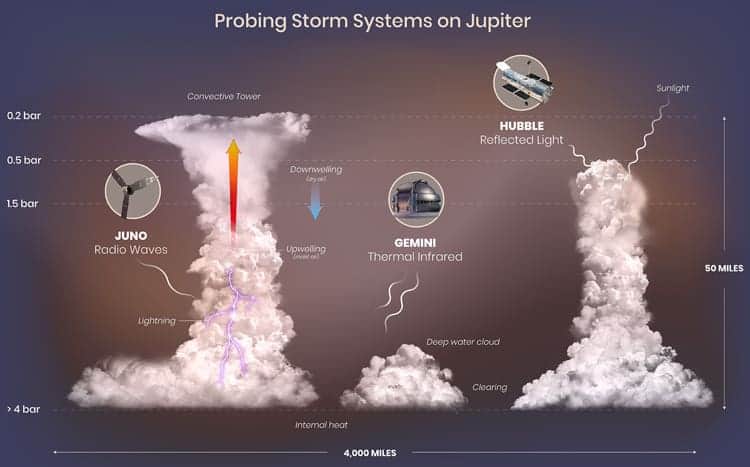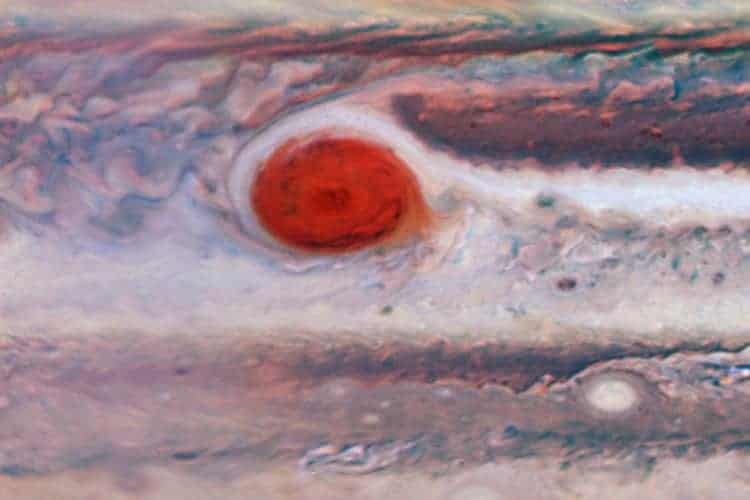Michael Wong is an astronomer, but he spends his days tracking storm systems and lightning flashes on Jupiter like some Earth-bound meteorologist looking for harbingers of bad weather.
Wong is far from being able to forecast Jovian weather, however. His goal, for now, is to understand the physics and chemistry of the roiling, changeable atmosphere of our solar system’s largest planet, where thunderheads are five times taller than those on Earth, and storm systems themselves can exceed the size of our planet.
He’s lucky to have the help of NASA’s Hubble Space Telescope and the ground-based Gemini North telescope in Hawaii, which have teamed up with the Juno spacecraft now orbiting Jupiter to probe the mightiest storms in the solar system that take place more than 500 million miles from Earth.
“We want to know how Jupiter’s atmosphere works,” said Wong, an associate researcher in UC Berkeley’s Center for Integrative Planetary Science.
Wong is part of a team of researchers that includes Imke de Pater, a Berkeley professor of astronomy, Amy Simon of NASA’s Goddard Space Flight Center in Greenbelt, Maryland, and Andrew Stephens at Gemini Observatory. Together, they combine multiwavelength observations from Hubble and Gemini with close-up views from Juno’s orbit to gain new insights into turbulent weather on this distant world.

Their latest results, now online in The Astrophysical Journal Supplement Series, show that lightning outbreaks are associated with a three-way combination of cloud structures: deep clouds made of water, large convective towers caused by upwelling of moist air — essentially Jovian thunderheads — and clear regions presumably caused by downwelling of drier air outside the convective towers.
Wong and de Pater saw the same three cloud structural elements associated with a lightning storm detected in 2017 by the Atacama Large Millimeter/Submillimeter Array (ALMA) in Chile and seen a month later by Juno.
The Hubble data indicate the height of the thick clouds in the convective towers, as well as the depth of water clouds deep in the planet. The Gemini data clearly reveal the clearings in the high-level clouds, where it is possible to get a glimpse down to the deep water clouds.
Wong thinks that lightning — which on Jupiter can be three times more energetic than the largest “superbolts” on Earth — is common in turbulent areas that are known as folded filamentary regions, their name suggesting that moist convection is occurring in them.
“These cyclonic vortices could be internal energy smokestacks, helping (to) release internal energy through convection,” he said. “It doesn’t happen everywhere, but something about these cyclones seems to facilitate convection.”
Wong credits numerous Berkeley students who have contributed to the project, including Josh Tollefson, now a postdoctoral scholar, who wrote the first science paper using the data; former undergraduates Megan Barnett and Andrew Hsu, who processed many gigabytes of Gemini and Hubble data; and doctoral student Charles Goullaud, who developed tools for polar mapping. Barnett and Hsu are now pursuing graduate studies at the University of Chicago and Florida Institute of Technology, respectively.
The regular imaging of Jupiter by Hubble and Gemini in support of the Juno mission is proving valuable in studies of many other weather phenomena, as well, including changes in wind patterns, characteristics of atmospheric waves and the circulation of various gases in the atmosphere.
The ability to correlate lightning with deep water clouds also gives researchers another tool for estimating the amount of water in Jupiter’s atmosphere, which is important for understanding how Jupiter and the other gas and ice giants formed, and, therefore, how the solar system as a whole formed.
“Because we now routinely have these high-resolution views from a couple of different observatories and wavelengths, we are learning so much more about Jupiter’s weather,” said Simon. “This is our equivalent of a weather satellite. We can finally start looking at weather cycles.”


